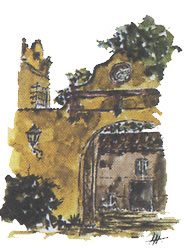Bacterial biocontrol - Tests for phytopathogenic fungi: Plate confrontation assay.
There are several beneficial bacteria for plants protecting them from diseases, such as rhizospheric or endophytic microorganisms, among which are species of Bacillus, Streptomyces, Pseudomonas and Burkholderia. Plant diseases caused by fungi are one of the limiting factors in crop production, causing considerable losses when they affect their yield or when they reduce the quality of the harvest, as occurs with the accumulation of high levels of mycotoxins, which make them unsafe for human or animal consumption. The integrated management of plant diseases, including cultivation methods, physical, chemical and biological methods are the most common recommendations to suppress plant diseases. However, chemical methods (fungicides) are often preferred due to their rapid and specific action. However, the extensive and indiscriminate use of chemicals in agricultural systems is generating environmental and health concerns. The frequent and intensive application of chemicals has also led to the development of fungicide resistance in many plant pathogens. In terms of their relationship with health, they are considered to be capable of affecting development, reproductive defects or even cancer.
Therefore, biological control of plant diseases is becoming increasingly important, as it is ecologically sustainable and environmentally safe. Most biocontrol agents (BCA) used for the suppression of plant diseases are microbial antagonists. Among BCAs, bacterial antagonists are the most widely used and studied. Plant-associated antagonistic bacteria have different mechanisms to act against plant pathogens, such as competition for nutrients, the production of antimicrobial metabolites such as antibiotics and lipopeptides, and the emission of volatile organic compounds (VOCs), such as ketones and sulfur compounds that can induce plant defense responses and/or antagonize plant pathogenic fungi.
These microbial biocontrol agents represent a safe alternative to the intensive use of agrochemicals, reside in close association with plant surfaces, i.e. leaves or roots, and protect the plant from phytopathogens by priming the plant´s defense response, competing for nutrients, and/or directly antagonizing the growth and development of pathogens.
Some species of bacteria from the genera Bacillus, Pseudomonas, Burkholderia, and Streptomyces have the ability to act against phytopathogenic fungi, and can also produce bioactive metabolites, with Bacillus spp. being the most important as biocontrol agents due to their ubiquity, adaptability, and endospore formation.
The assessment of biocontrol agents (BCA) is important and should be carried out as completely as possible, as failure to do so may lead to failure of the product´s efficacy during actual use.
Classical antagonistic tests, known as dual culture, plate confrontation or zone of inhibition assays, evaluate the effect of candidate microorganisms to be biocontrol agents against a phytopathogenic fungus by co-inoculation in solid culture media or in liquid culture media.
The solid agar plate confrontation test to demonstrate the inhibition of mycelial development is the most widely used in vitro detection method for the preliminary selection of microorganisms used for biocontrol. A high correlation with tests on plants has been shown. However, there are different ways of carrying out the test, so sometimes the results obtained in different evaluations are not comparable.
On the other hand, it should be noted that although the inhibitory effect of specific bacteria is well documented, sometimes tests are not carried out to identify truly competent biocontrol agents, so many potential biocontrol agents ultimately fail to suppress plant diseases in field trials.
There are methods that take into account numerous factors, including competition for nutrients or space, cell surface components, and induced or constitutive secretion of volatile or soluble metabolites. Other antagonistic assays evaluate the effect of individual inhibitory components, such as volatiles, polyketides, lipopeptides, siderophores, and lytic enzymes, including chitinases, glucanases, and proteases, on the growth of phytopathogens.
At IVAMI we carry out the solid agar plate confrontation test. The test is carried out in triplicate for the plates on which the bacteria (or the product containing it) and the chosen phytopathogenic fungus are placed, and also for the control plates, inoculated only with the phytopathogenic fungus. The bacterium (or the product containing it) is used at several concentrations, usually 5, unless more concentrations are chosen by the client, since the inhibition may depend, and the results obtained may vary depending, on the quantity of bacteria used. In a basic test, 15 challenge cultures are carried out, plus 3 fungal growth control cultures. The results are read every 24 hours during 5 or 7 days of incubation, depending on the speed of development of the phytopathogenic fungus. In each reading of the results and on each plate, the fungal growth radii are measured in two directions and the inhibition zones between the bacteria and the fungal growth are measured. The inhibition indices are calculated with the values obtained. At the end of the test, microscopic observation of the edges of the fungal growth is carried out to determine whether there are morphological alterations in its hyphae.



